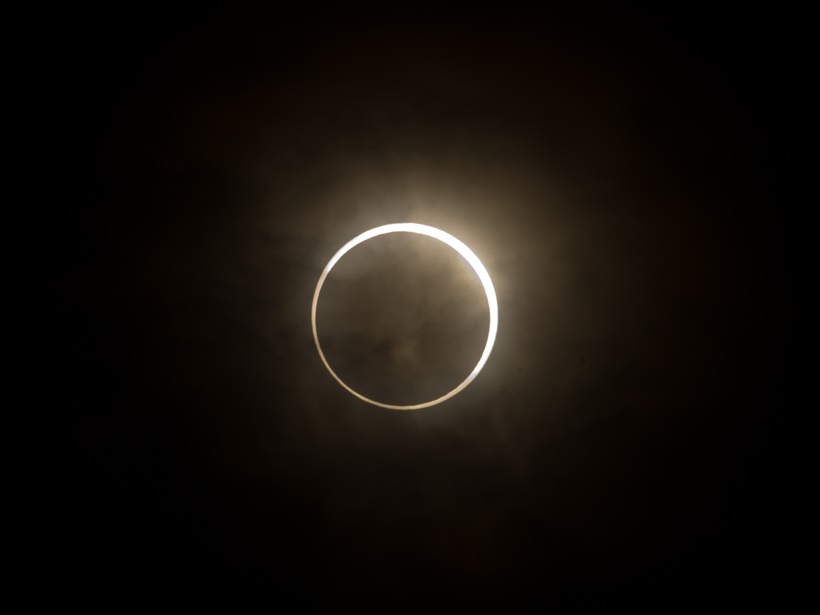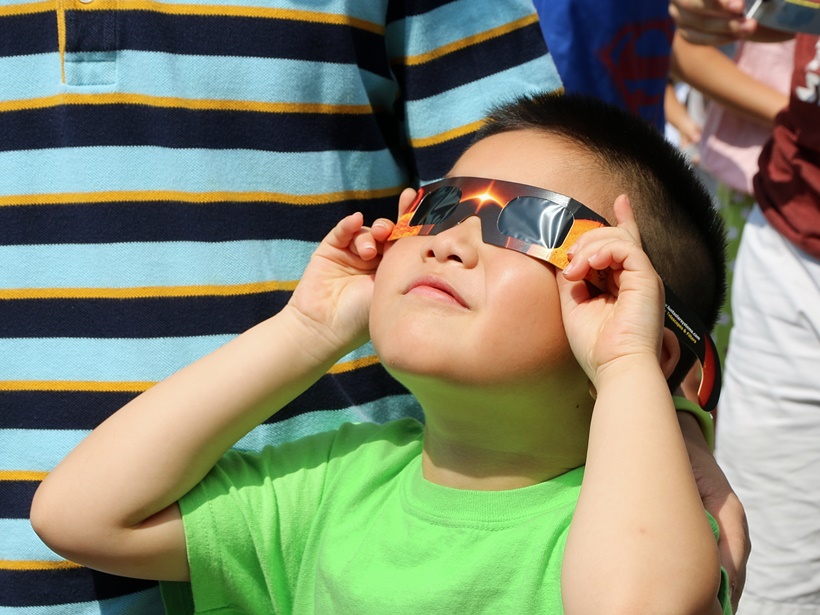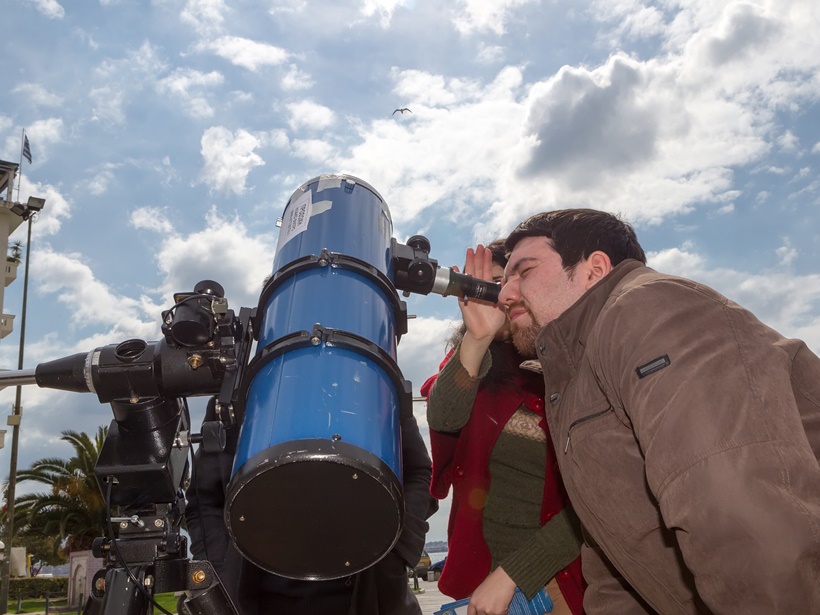Surya Grahan or Solar Eclipse 2018: Everything you wanted to know about a solar eclipse—why it happens, how to watch and safety tips!
By Rishabh Jain
What is a Solar Eclipse?
Every once in a while, The Earth, Moon and Sun come in a straight line. This could last from several minutes to several hours, depending upon which kind of eclipse it is. When seen from the Earth, the Moon seems to cover up the Sun, totally or partially, depending upon how precise the alignment is. This is called a Solar Eclipse or Eclipse of the Sun. You would be surprised to know that the size of the Moon and the size of the Sun in the sky is exactly the same (well, almost). If you keep your thumb at one arm distance, you can actually hide both of them behind it. This is true because the Moon is 400 times smaller than the Sun and 400 times nearer the Sun is to Earth. It is such a coincidence. This alignment has to be very precise, or the eclipse won’t happen, even if you are off by a fraction of a degree.
How often does a Solar Eclipse occur?
Eclipses are not that rare actually. The key is to be at the right spot at the right time and Solar eclipses are visible over a very narrow path. To understand how this works, we first need to go back to Class 5 science. Earth, Moon and Sun come in a line about 13 times in a year, as the
Earth revolves around the Sun and the Moon revolves around the Earth. They are aligned perfectly only a fraction of times, otherwise you would have seen an eclipse, once every month.
This doesn’t mean that eclipses are very rare. You can see about seven Solar and Lunar eclipses in a year. A maximum of five Solar or five Lunar.
Are there different kind of Eclipses?
Yes. There are three kind of Solar Eclipses. The ones seen most often are:
There is a fourth kind and it is extremely rare. It is called a Hybrid where the eclipse may change from an Annular to a Total and vice-versa. There is also a fifth kind which is rarest of the lot. It is called a beaded Annular. You can actually see a necklace of sunlight beads around the Moon in this eclipse and it is a spectacle you will never forget. You will need some special techniques to observe it though.


Why do different kind of Eclipses happen?
Different kinds of eclipses happen because the orbit of Moon around the Earth is not exactly a circle. It is an ellipse, also known as an oval. Because of this, the Moon is nearer or farther from the Earth on different days and for the same reason it appears bigger or smaller in the sky. The size of the Sun remains more or less the same (very little difference).
Because of this dance of Moon around the Earth, when the Moon is nearer to Earth, we get to see a Total Eclipse and when it is farther away we get to see an Annular Eclipse. When it is somewhere in between near and far, we get to see a Hybrid or a beaded Annular Eclipse. Most of the time, there is a partial or no eclipse as the Moon misses the alignment. This happens because apart from being oval, the orbit is also tilted. So as seen from the Earth, the Moon may just pass below or above the Sun (No eclipse) or just graze past it (Partial eclipse). To experience this on your own, tie a string on a tennis ball and revolve it around your head. You will notice how the ball doesn’t pass in front of your eyes at the same spot every time. It will also be nearer sometimes and sometimes farther. All of this happens because of the gravity of the Earth when it comes to the Earth and the Moon.
What to observe when a solar eclipse is going on?
A Solar eclipse is one of the most fascinating events you will get to see so many things happening right in front of you. You will notice apart from the great celestial performance of the three heavenly bodies, there are so many things which are happening around you:
Birds go home early, become disoriented.
Most birds go home at sunset after spending a long day outside, collecting food and other resources for themselves and their family. The sunset helps them understand in which direction they have to fly in. On the day of the eclipse, the sunlight suddenly dims down to sunset levels and birds in a confusion go in the wrong direction while thinking that the day has ended early and it is time to go home.
After the eclipse gets over, many birds are seen flying back to the original spots to continue their work. Imagine what an experience it must be for them.
Many animals get awestruck by the happenings around them and some of them are seen standing at the same spot or finding a safe area while the eclipse is going on. Animals know, there is something different in the sky during the eclipse hours.
The temperature suddenly drops, winds start blowing
When the sun gets covered completely by the Moon (also known as Totality), there is sudden darkness and a very sharp drop in temperature. You get goosebumps and as the winds start blowing, it feels like a movie scene. It is overwhelming for your senses as you don’t know what to make of it.
You can see planets and stars during the day
As the sky gets dark, planets which are close to the sun and are not visible otherwise are clearly seen, in the middle of the day. If you search the internet, you will see images with a twilight sky and little dots embedded everywhere. The bright ones are generally planets and the dim ones are stars. This reminds of the days when my science teacher used to tell me about how stars are not visible during the day time as the light of the Sun is too bright. Hence, proved.


The slow countdown to Totality
As the partial phases progress, the eclipsed Sun gets smaller and then the celestial gala starts. You will first get to see a set of beads as the last few valleys of the Moon let the light of the Sun through. The final valley lets the last direct rays of Sun through and one gets to see, what is better known as the Diamond ring because of its appearance. Once the diamond ring event is over, the sun is covered fully by the Moon and this is known as Totality.
It is compulsory to use safe Solar Observation techniques mentioned in the article to observe the Sun during all parts of the eclipse except for the Totality part.
You may get to see “Shadow Bands”, or snake like patters moving on the ground or on walls as shadows mix with each other. Don’t worry, it is normal. Make sure you at least have an action camera rolling to capture the ambient changes during an eclipse.
People start crying, jumping with joy
This is the only time when you can stare at the Sun, without damaging your eyes. When you look at the Sun during the Totality, you can see the thread like atmosphere, which shines like bright white pearls. There is so much emotion in the air. Believe me, as I write this, I am getting goosebumps remembering the last Total Solar Eclipse I saw. I was shouting and jumping while tears of joy were rolling down my cheeks. I looked around and I realised that I wasn’t the only one who was doing this.
You will shout first and then become speechless
You will shout “look up in the sky, look at the eclipse” and after a while, it will be just a calm atmosphere. It will make you speechless as you will be still trying to understand what just happened.
You will never get to know when it ends.
The eclipse will get over before you even realise. All the phases start happening in the reverse direction, first the diamond ring, the beads and the partial phases. Once the eclipse ends, you will start asking, when is the next one?
When and where is the next solar eclipse?
As eclipses keep on happening throughout the year, organisations maintain a populated list of the ones that have happened in the past and are due to happen in the future. The best place to access this data is by visiting eclipse.nasa.gov (NASA website for eclipses).
You will get to access very interesting information and you can start planning for the upcoming eclipses, well in advance. Planning is needed because you have to be at the correct location and at the right time. Remember, there are others who are planning to do the same. Ensure that you just concentrate on watching your first eclipse, because you will watch many after this one and you can always take good photos later because you will know what to expect.
How can you observe a Solar Eclipse safely?


Watching the Sun directly is unsafe and it may damage your eyes permanently. However, you can observe an eclipse using several safe techniques. The simplest ways are the most interesting:
Pinhole Projection
The safest way of watching an eclipse is by using the pinhole projection method. This can be done using anything which has a small hole. Try by making a pin prick on a card and go near a wall. Hold the card in a way that the light of the Sun passes through the hole. You will see an image of the Sun on the wall. You can try the same the same with a bulb or a tube light inside your house and you will see the image of a bulb or tube light. Partially eclipsed sun will show proper phases. This technique is used when all other techniques/equipment fail and is by far the safest way of watching the Sun.
Certified Solar Filters
There are certified filters available in the market which cut the light of the Sun by about 100,000 times. These are not X-rays or photo filters. These are specially formulated filters build precisely for the purpose of watching the Sun. You may google Rainbow Symphony or Baader to see what kind of filters are available in the market. These filters are put into cardboard spectacles and popularly sold as Eclipses glasses. If you procure a piece, make sure you preserve it. I have eclipse glass that are 15 years old and they still work well.
Mirror Reflection
Just take a large mirror and shine the image in a dark room. You will see the exact image of the Sun. Make sure to look at the reflection and not at the mirror directly.
Welder Glasses
A 14 number welder glass will be a good option to view the eclipse safely. Make sure you get it from a trusted source.
Filtered Telescope
The views are the best using a telescope but there is a fair disclaimer which comes along with it. Solar filters are mounted on a telescope where light enters it. These filters are tested for any light leakage before they are used. Most high resolution images of the eclipse sun are taken using such setups. The method is a tricky one and you should leave it to the Pros unless someone has trained you to observe properly as when wrongly done, you can burn a hole in your eye.


Telescope Projection
Like pinhole projection, light of the Sun is allowed to pass through the telescope and you can get good views of the eclipse. One requires an all-metal body telescope for this. My advice is to do this in the presence of a person who has done this a few times before.
Every other way that you have heard or seen is NOT SAFE. Kindly avoid them. Your eyes are very precious and vision once lost will not come back. In case you feel you need to know more, contact the local astronomy club and they will take you through the process.
I want to see an eclipse but I can’t travel to the location
A lot of people are unable to chase eclipses due to several reasons. In such cases, you can watch a live webcast of the event. The keywords you need to search for are “Slooh” or “NASA Eclipse” and the internet will do the rest for you.
Will watching a Solar Eclipse affect my health or fortune?
Eclipses are fun to watch and they don’t affect your health or fortune. One thing is for sure, you will become addicted to eclipses and become an eclipse chaser immediately after watching a Solar Eclipse. Eclipse chasers get to see the world because eclipses happen in different continents every time, including Antarctica. Eclipses are simple geometry which happen in the Universe. Everything else about them is pure entertainment. Grab some popcorn and add some butter (to taste) and grab a seat on your couch.
Basically, you can eat food, drink water, play, sing, dance, read, draw and do everything else you that you do on a normal day. If eclipses caused problems, we wouldn’t have a population problem in the world.
(Rishabh is popularly known as ‘astronomy guru’ to friends and colleagues and has an asteroid discovery to his credit. He is the founder of Telescope Watch (www.telescopewatch.in), a non-profit which aims to spread awareness about science and astronomy. On a random day, you may find him in your neighbourhood, showing the moon and planets to everyone who passes by. When he is not doing astronomy, he spends his time with EdTerra Edventures and creates fun travel programmes for school students.)
Source: Read Full Article
